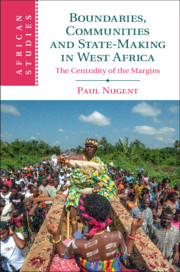Book contents
- Boundaries, Communities and State-Making in West Africa
- African Studies Series
- Boundaries, Communities and State-Making in West Africa
- Copyright page
- Dedication
- Contents
- Figures
- Maps
- Tables
- Acknowledgements
- Abbreviations
- 1 Centring the Margins
- Part I From Frontiers to Boundaries
- Part II States and Taxes, Land and Mobility
- 4 Constructing the Compound, Keeping the Gate
- 5 Being Seen Like a State
- 6 Border Regulation and State-Making at the Margins
- 7 Land, Belief and Belonging in the Borderlands
- Part III Decolonization and Boundary Closure, c.1939–1969
- Part IV States, Social Contracts and Respacing from Below, c.1970–2010
- Conclusion
- Bibliography
- Index
- African Studies Series
7 - Land, Belief and Belonging in the Borderlands
from Part II - States and Taxes, Land and Mobility
Published online by Cambridge University Press: 08 June 2019
- Boundaries, Communities and State-Making in West Africa
- African Studies Series
- Boundaries, Communities and State-Making in West Africa
- Copyright page
- Dedication
- Contents
- Figures
- Maps
- Tables
- Acknowledgements
- Abbreviations
- 1 Centring the Margins
- Part I From Frontiers to Boundaries
- Part II States and Taxes, Land and Mobility
- 4 Constructing the Compound, Keeping the Gate
- 5 Being Seen Like a State
- 6 Border Regulation and State-Making at the Margins
- 7 Land, Belief and Belonging in the Borderlands
- Part III Decolonization and Boundary Closure, c.1939–1969
- Part IV States, Social Contracts and Respacing from Below, c.1970–2010
- Conclusion
- Bibliography
- Index
- African Studies Series
Summary
Having highlighted the role of colonial states in either facilitating or inhibiting mobility, I now consider the implications for framings of identity in the two regions concerned. As I have indicated in Chapter 2, the demography of frontier zones in the nineteenth century was often highly fluid, and this was accentuated by the political turbulence around the time when the borders were being demarcated. In that sense, the cherished notion that fixed communities were destabilized by the imposition of colonial borders is somewhat problematic. Whereas flight and displacement had been a feature of the frontier regions in the later nineteenth century, colonial regimes had an interest in fixing populations in productive spaces whilst regulating the flow of migrants. Whether people were at liberty to cross a border and to access land on the other side, or not, had a very practical bearing on the issue of what it meant to claim membership of a community. In the trans-Volta, as we will see, the casting of settlers as strangers entailed a perpetual disability, whereas a more open regime in the Senegambia tended to erode the distinction between indigenes and more recent arrivals. In the first case strangers tended to be sectioned off in distinct residential quarters, whereas in the second the settlement patterns were more interspersed. This, in turn, had a bearing on the practical salience that was attached to ethnicity when projected onto a larger canvas.
- Type
- Chapter
- Information
- Boundaries, Communities and State-Making in West AfricaThe Centrality of the Margins, pp. 272 - 312Publisher: Cambridge University PressPrint publication year: 2019



